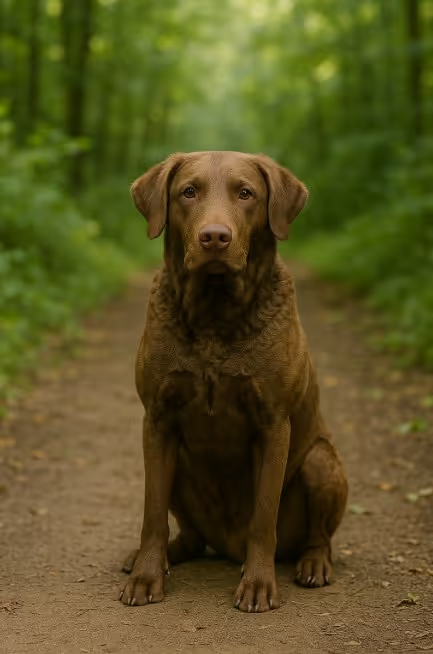The Chesapeake Bay Retriever (“Chessie”) is a powerful, weatherproof waterfowl retriever famed for its oily, wavy coat, stamina in icy water, and steadfast loyalty. Affectionate with family and sensible with strangers, Chessies are biddable yet independent thinkers who thrive with clear training, daily exercise, and real jobs like retrieving, dock diving, or scent work. If you’re asking “Are Chesapeake Bay Retrievers good family dogs?”—yes, in active, training-minded homes. “Do Chessies shed?”—moderate to heavy seasonally. “Are Chesapeake Bay Retrievers hypoallergenic?”—no.

Developed along Maryland’s and Virginia’s Chesapeake Bay in the early 1800s, the breed descends from shipwrecked Newfoundlands/St. John’s water dogs crossed with local hounds and setters. Bay hunters needed a strong, ice-breaking retriever with a weatherproof coat, keen nose, and tireless work ethic to haul boats and retrieve multiple ducks in frigid waters. Recognized by major registries (CKC/AKC), Chessies remain premier waterfowl partners and excel in hunt tests, field trials, tracking, and search work.
A muscular, medium-large retriever built for power, endurance, and cold water.
Low trimming, targeted de-shedding, and protecting the natural coat oils.
A serious worker that needs daily body + brain work.
Smart, determined, and loyal—keep training clear, fair, and purposeful.
Fuel athletic work while keeping a lean outline for joint health.
Generally robust; responsible screening is essential in working lines.
Look for health-tested, field-sensible dogs—or consider rescue.
Are Chesapeake Bay Retrievers good family dogs?
Yes—loyal and affectionate in active homes with consistent training and daily exercise.
Do Chesapeake Bay Retrievers shed a lot?
Moderate to heavy seasonally. Daily brushing during coat blow helps.
Are Chesapeake Bay Retrievers hypoallergenic?
No. They are not hypoallergenic.
How much exercise does a Chesapeake Bay Retriever need?
Plan for 60–90 minutes daily, ideally with retrieving and swim work.
Do Chessies need special grooming?
Protect the natural coat oils—don’t over-bathe; rinse after swims and dry ears thoroughly.
Are Chessies good apartment dogs?
Possible for very active owners with robust exercise and enrichment; easier with access to water/fields.
Chesapeake Bay Retriever vs Labrador—what’s different?
Chessies are typically more protective/independent with an oily, wavy coat (brown/sedge/deadgrass); Labs are often more social with a smoother coat and broader colour range.
What health tests should breeders do?
Hips/elbows, CAER eyes, and DNA for EIC, PRA-prcd, and DM—ask to see documentation.
Do Chessies get ear infections?
They can—especially after swimming. Clean and dry ears weekly (and after water work).